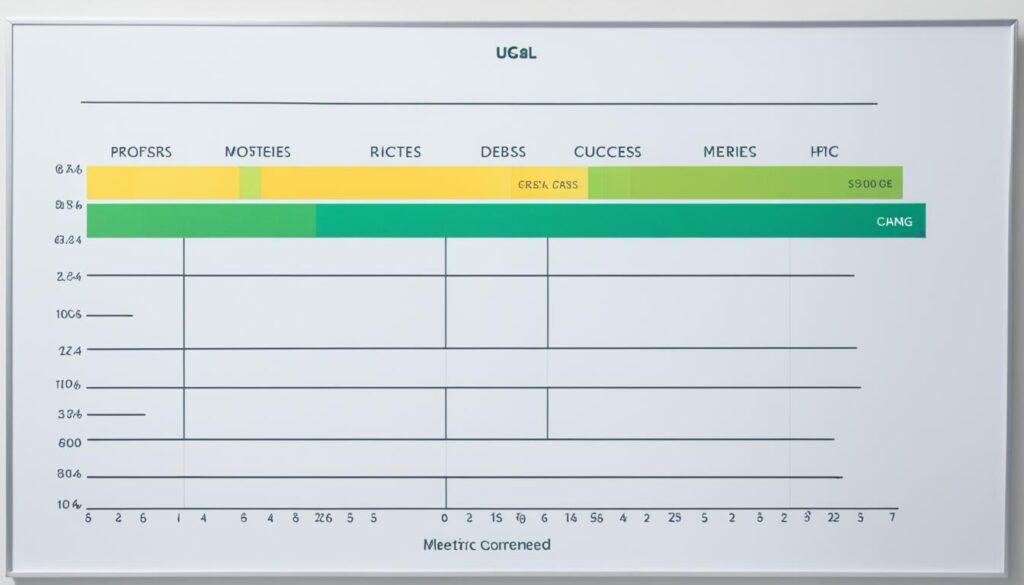As a change practitioner, measuring the success of your change management activities is crucial for achieving successful outcomes in your change projects. Research has shown a positive correlation between measuring compliance, overall performance, and meeting project objectives. To effectively gauge the success of your change management efforts, it is essential to define success at the project initiation stage, including identifying project objectives and organizational benefits.
Engaging key stakeholders early on to co-create a shared definition of success and identify any misalignments is vital. Encourage project sponsors to define success criteria early in the process and include “people side” metrics that capture the impact on individuals and the organization. It is also important to limit the number of success metrics to focus on the most relevant indicators.
Key Takeaways:
- Measuring change management success is crucial for achieving successful outcomes in change projects.
- Defining success at the project initiation stage helps identify key objectives and organizational benefits.
- Engaging key stakeholders and co-creating a shared definition of success is essential.
- Including “people side” metrics and limiting the number of success metrics enhances measurement effectiveness.
- Measuring compliance, overall performance, and meeting project objectives correlates with successful change management.
The Importance of Measuring Change Management Effectiveness
Measuring change management effectiveness is crucial for assessing change management effectiveness and evaluating change management outcomes. It plays a significant role in driving meaningful progress in organizations. When change success is not clearly defined for projects, it often stems from a lack of alignment on goals and objectives. To ensure successful change management, it is essential to engage key stakeholders in defining success and identifying appropriate key performance indicators (KPIs).
Measuring compliance, overall performance, and meeting project objectives are closely linked to successful change management. These metrics help organizations evaluate the effectiveness of their change initiatives and determine if they are on track to achieve desired outcomes. However, identifying the right KPIs can be challenging.
- Encouraging clear success criteria is essential to overcome the difficulty in identifying KPIs. By having well-defined success criteria, organizations can effectively measure change management effectiveness.
- Advocating for a holistic definition of success ensures that all aspects of the change are considered, including the impact on individuals, teams, and the entire organization.
- Introducing “people side” metrics early in the change management process allows for a more comprehensive assessment of change management effectiveness. These metrics focus on the human aspect of change, such as employee engagement, satisfaction, and readiness.
- Limiting the number of metrics is important to prevent data overload and ensure that the chosen metrics are meaningful and actionable.
By following these strategies, organizations can effectively measure change management effectiveness and evaluate the outcomes of their change management efforts. It provides valuable insights into the success of change initiatives and enables organizations to make informed decisions to drive continuous improvement.
“Measuring change management effectiveness is like using a compass to navigate through uncharted territories. It helps organizations stay on course, make course corrections when needed, and ultimately reach their desired destination of successful change.”
To visually represent the importance of measuring change management effectiveness, refer to the following image:
Now that we understand the significance of measuring change management effectiveness, let’s explore the three levels of performance metrics for change management projects in the next section.
Three Levels of Performance Metrics for Change Management Projects
Measuring and monitoring change management effectiveness is essential to gauge the success of your change management projects. By utilizing the appropriate performance metrics, you can assess the impact of your change initiatives and identify areas for improvement. This section explores three levels of performance metrics that provide a holistic framework for measuring the overall success of change management projects.
Change Management Performance Metrics
The first level of performance metrics focuses on the completion, execution, and effectiveness of your change management methodology. These metrics enable you to evaluate how well your change management processes and strategies are implemented and followed. By monitoring these indicators, you can ensure that your change management approach is robust and aligns with your project objectives.
Individual Performance Metrics
The second level of performance metrics assesses the progress of individual transitions through the ADKAR model. This model focuses on the five stages of individual change: awareness, desire, knowledge, ability, and reinforcement. Measuring individual performance metrics allows you to track the speed of adoption, the ultimate utilization of the change, and the proficiency in applying the new processes or systems. It provides insights into the effectiveness of your change management efforts at the individual level.
Organizational Performance Metrics
The third level of performance metrics evaluates the overall impact of your change management initiatives on the organization. These metrics determine if your change initiative delivered the expected results and achieved the defined project objectives and organizational benefits. By measuring organizational performance metrics, you can quantify the success of your change management projects and identify areas where additional support or adjustments may be needed.
To effectively monitor change management performance, it is crucial to establish clear change management success indicators and regularly review and track these metrics. This enables you to proactively identify any gaps or areas for improvement, ensuring the success of your change management endeavors.
“Effective change management requires measuring and monitoring performance at multiple levels to gain a comprehensive understanding of the success of your change initiatives.”
Remember that measuring change management performance is an ongoing process. Regularly review your performance metrics, gather feedback, and make iterative improvements to optimize your change management efforts.

Measuring Change Success at the Organizational Level
When it comes to organizational-level changes, it’s crucial to assess whether all employees are following the new rules or using the new systems. Quantifying change management progress involves tracking change management results and ensuring that the change aligns with organizational goals.
Surveys and metrics play a vital role in measuring the success of organizational change. For instance, the speed of execution, benefit realization, project key performance indicators (KPIs), and compliance reports can provide valuable insights into the effectiveness of the change. Additionally, employee feedback and satisfaction surveys offer perspectives on how the change impacts individuals and the overall organization.
![]()
By tracking these metrics and gathering employee feedback, organizations can understand the impact of their change initiatives and make data-driven decisions to enhance change management strategies. It’s essential to continuously evaluate change success at the organizational level to ensure that desired outcomes are achieved and the organization thrives in the ever-evolving business landscape.
Measuring Change Success at the Operational Level
Operational changes play a vital role in achieving organizational goals and improving overall efficiency. The success of these changes can be measured using specific metrics that assess their impact on daily operations. By closely monitoring key indicators, organizations can gauge the effectiveness of their change management efforts at the operational level.
Key Metrics for Measuring Change Management Impact
When evaluating operational change success, it is essential to track relevant metrics that provide insights into the impact of the change. Some important change management success metrics include:
- User Login Volume: Monitoring the number of users logging into the new system or platform can indicate the level of adoption and employee engagement.
- Transaction Volume: Tracking the volume of transactions processed through the changed processes or systems helps assess the efficiency and effectiveness of the operational change.
- Compliance: Evaluating the degree of compliance with the new policies or procedures demonstrates the successful implementation of the change and adherence to organizational standards.
- Quality of Work: Assessing the quality of work output following the operational change ensures that the desired improvements have been achieved.
These metrics provide tangible evidence of the impact the operational change has had on the organization’s day-to-day activities.
Insights from Feedback
Collecting feedback from various stakeholders is crucial to gaining a comprehensive understanding of the success of operational change. Feedback can be gathered from employees, shareholders, and customers to obtain diverse perspectives on the change’s impact. Their insights can shed light on how well the change has been received and provide valuable information for further improvement.
“By incorporating feedback from employees, shareholders, and customers, organizations can gather valuable insights and make data-driven decisions to enhance operational change.”
This feedback can be obtained through surveys, focus groups, or direct interactions. It enables organizations to identify any gaps or areas of concern, allowing for targeted interventions and continuous improvement.

Measuring change success at the operational level provides organizations with valuable data to assess the effectiveness of their change management strategies. By tracking key metrics and gathering feedback, organizations can make informed decisions, drive further improvements, and ensure the successful implementation of operational changes.
Measuring Culture Change
Culture change is often the most challenging and difficult to measure, as it involves changing human behavior. However, monitoring the performance of culture change initiatives is crucial for evaluating their success and identifying areas for improvement.
Employee surveys, focus groups, and internal help desk metrics can provide valuable insights into the effectiveness of culture change efforts. These tools allow you to gather feedback directly from employees, understand their experiences, and identify any areas of concern.

“Employee surveys, focus groups, and internal help desk metrics can provide insights into the success of culture change efforts.”
Additionally, employee feedback and satisfaction surveys can help gauge the impact of culture change on their overall experience. By collecting data on employee perceptions and sentiments, you can assess the effectiveness of your culture change initiatives and make necessary adjustments to ensure their long-term success.
Measuring the sustainability of culture change is also crucial. Evaluating whether the change has truly “stuck” over time is important to determine the lasting impact on your organization’s culture and behavior.
By effectively monitoring change management performance and utilizing change management success indicators, you can gain valuable insights, track progress, and make data-driven decisions to enhance the effectiveness of your culture change efforts.
The Role of Communication in Measuring Change Success
Effective communication plays a vital role in successful change management, and measuring communication effectiveness is essential for evaluating the success of change initiatives. By employing various tools and techniques, organizations can gain valuable insights into the impact of their communication efforts on employee awareness and preparedness.
One way to measure communication effectiveness is through the use of technology tools. These tools allow organizations to track employee engagement with communication messages and learning materials. By analyzing data such as open rates, click-through rates, and completion rates, organizations can assess the effectiveness of their communication strategies and make necessary adjustments.
Internal help desk metrics can also provide valuable indicators of communication impact. Monitoring ticket volume related to change management and resolution areas can help gauge the effectiveness of communication in addressing employee concerns and questions. This data can inform organizations about areas of improvement and help them fine-tune their communication approach.
However, quantifying the qualitative aspects of communication is equally important. Surveys and feedback loops enable organizations to collect tangible insights into the impact of communication on employee awareness, understanding, and alignment with the change. By asking targeted questions and actively listening to employee feedback, organizations can identify gaps and refine their communication strategies.
“Effective communication is not just about sending messages; it’s about ensuring that the intended message is received, understood, and acted upon by employees.”
By taking a comprehensive approach to measuring communication effectiveness, organizations can enhance their change management success metrics. Combining quantitative data from technology tools and internal help desk metrics with qualitative data from surveys and feedback loops provides a well-rounded view of the impact of communication on change success.
Next, we’ll explore how employee readiness and engagement serve as key metrics for evaluating change management success.
Employee Readiness and Engagement as Key Metrics
When it comes to measuring the success of change management efforts, assessing employee readiness and engagement are crucial. These metrics provide valuable insights into whether employees understand the change and have the necessary knowledge and ability to transition effectively. Additionally, employee engagement measures the level of buy-in and active participation in the change process, indicating the overall receptiveness of the workforce.
One way to track employee readiness is through employee readiness assessments. These assessments evaluate employees’ comprehension of the change and their preparedness to navigate it successfully. By identifying gaps in understanding or proficiency, organizations can provide targeted support and training, ensuring that employees are well-equipped to embrace the change.
Employee engagement, on the other hand, focuses on the emotional connection and commitment of individuals to the change initiative. Engaged employees show enthusiasm, motivation, and active involvement in the implementation of the change. This level of engagement is vital because it significantly influences the overall success of change management efforts.
To effectively measure employee readiness and engagement, organizations can employ various tools and techniques. Surveys, for instance, can provide valuable feedback on employees’ perceptions, concerns, and level of readiness. Training participation and effectiveness measures also offer insights into employees’ willingness to learn and embrace the change.
“Measuring employee readiness and engagement are critical metrics for change success.”
Another important aspect of tracking these metrics is the establishment of feedback mechanisms. By creating channels for employees to express their thoughts, concerns, and suggestions, organizations can foster a culture of open communication and continuous improvement. This feedback can guide refinement and adjustment of change management strategies, ultimately enhancing employee readiness and engagement.
As organizations strive for successful change management, keeping a close eye on employee readiness and engagement is paramount. These metrics not only provide insights into the effectiveness of change efforts but also guide the identification of areas for improvement. By prioritizing employee readiness and engagement, organizations can better navigate change and achieve sustainable success.

Incorporating Feedback and Accountability in Change Management
Feedback plays a critical role in measuring change management success. By creating a feedback loop early in the change process, you can gather valuable insights from employees and identify areas for improvement. Surveys, focus groups, and internal help desk metrics are effective tools for collecting employee feedback and determining the success of your change implementation.
Encouraging open and honest communication allows you to address concerns, refine strategies, and ensure that the change is meeting the needs of your employees. By actively listening to their feedback, you can identify any potential obstacles or resistance to change and take appropriate measures to address them.
In addition to feedback, accountability is essential for driving change management success. Holding managers accountable for supporting the change and ensuring their teams follow through on their responsibilities is vital. By establishing clear expectations and providing the necessary resources, you can foster a sense of ownership and responsibility among managers and their teams.
“The most valuable feedback comes from employees who have been impacted by the change. Their insights can provide valuable guidance on how to improve the change management process and ensure that it aligns with their needs. By incorporating employee feedback and fostering a culture of accountability, you can drive successful change implementation.”
– Emily Patterson, Change Management Expert
Remember, incorporating feedback and fostering accountability are ongoing processes. Continuously seek employee input throughout the change journey, and regularly assess and address any areas that require improvement. By doing so, you can enhance the success of your change management efforts and achieve your desired outcomes.
Evaluating Business Preparedness for Change
Before communicating a change to employees, it is crucial to evaluate if the business is adequately prepared. This evaluation involves assessing readiness on both the process and systems side to ensure a smooth transition for employees. By evaluating various metrics, you can gauge if the business is ready for the change and if employees are adequately prepared to embrace it.
One important metric to consider is communication effectiveness. Assessing how effectively communication related to the change is being delivered and received can provide insights into the readiness of the business. By monitoring metrics such as message open rates, click-through rates, and employee engagement with communication materials, you can gauge the level of awareness and understanding among employees.
Another relevant metric is training participation. By tracking the number of employees who have completed the required training for the proposed change, you can assess their readiness to implement the new processes or systems. Training participation metrics can help identify any gaps in knowledge or skill acquisition that may hinder the successful adoption of the change.
Internal help desk metrics can also provide valuable insights into the preparedness of the business. By analyzing metrics such as the volume and nature of employee inquiries, you can identify potential areas of concern or confusion. This information can guide targeted interventions to address specific challenges and ensure employees are adequately prepared for the change.
Assessing business preparedness for change is crucial to ensure a smooth transition for employees and the successful implementation of the proposed initiatives. By evaluating metrics such as communication effectiveness, training participation, and internal help desk metrics, you can identify any readiness gaps and proactively address them.
By using these change management success metrics, you can confidently communicate the upcoming change knowing that the business is adequately prepared. This not only increases the chances of a successful transition but also minimizes potential disruptions and enhances employee acceptance of the change.
Measuring Change Management Performance
Effective evaluation of change management activities requires the measurement of change management performance. By assessing various metrics, organizations can gauge the effectiveness and progress of their change management efforts.
The completeness of the change management strategy serves as an important indicator of performance. A well-defined and comprehensive strategy ensures that all necessary steps and processes are considered, leading to more successful outcomes.
Monitoring the progress in executing the strategy provides valuable insights into the effectiveness of change management practitioners. This includes observing the adherence to timelines, milestones, and key action steps, ensuring that the strategy is being implemented as intended.
Another crucial metric to consider is the completion of the change management plan. A fully executed plan demonstrates the commitment and dedication of change management practitioners in driving change forward.
Furthermore, tracking project Key Performance Indicators (KPIs) and benefit realization allows organizations to assess the impact of change management efforts. Project KPIs measure the progress and overall success of the change initiative, while benefit realization focuses on the achievement of expected outcomes and organizational benefits.
Throughout the change process, it is essential to monitor progress and observe behavioral changes. This provides valuable insights into the effectiveness of change management activities, highlighting areas of success and areas that may require additional attention.
“Monitoring change management performance is key to ensuring that change initiatives are implemented successfully and deliver the desired results.”
By measuring change management performance using these indicators, organizations can make informed decisions, identify areas for improvement, and ultimately drive more successful change initiatives.
Conclusion
In conclusion, tracking change management results and evaluating change management outcomes are essential for organizations embarking on change initiatives. To measure change management success effectively, it is crucial to establish clear definitions of success at the project initiation stage and engage key stakeholders to co-create a shared understanding of success. By monitoring key performance indicators and incorporating feedback from employees, organizations can evaluate the impact and effectiveness of their change management efforts.
Measuring change management success should encompass various levels, including organizational, operational, and cultural changes, as well as change management performance. Organizational-level metrics such as compliance reports and surveys can track the success of changes that impact all employees. Operational-level metrics like transaction volume and user login volume provide insights into the success of changes at the departmental level. Measuring culture change requires employee surveys and feedback loops to gauge the impact on behavior and employee experience.
Measuring change success also involves assessing communication effectiveness, employee readiness, and engagement. Tracking employee engagement with communication messages, conducting readiness assessments, and monitoring employee feedback contribute to evaluating change success. Moreover, evaluating business preparedness for change through metrics such as communication effectiveness and training participation ensures a smooth transition for employees. By consistently monitoring change management performance through project KPIs, benefit realization, and progress in executing the change management plan, organizations can gain valuable insights into the overall performance of their change management efforts.
In summary, tracking change management results and evaluating change management outcomes enable organizations to effectively assess the impact and effectiveness of their change initiatives. By employing appropriate metrics, engaging stakeholders, and incorporating feedback, organizations can drive successful change and continuously improve their change management practices.
FAQ
How can I gauge my change management success effectively?
To gauge your change management success effectively, it is important to define success at the project initiation stage, engage key stakeholders in co-creating a shared definition of success, and identify misalignments. Encourage project sponsors to define success criteria early, include “people side” metrics, and limit the number of success metrics.
Why is measuring change management effectiveness important?
Measuring change management effectiveness is important for driving meaningful progress in organizations. It helps align goals and objectives, track compliance, overall performance, meeting project objectives, and ensures successful change management.
What are the three levels of performance metrics for change management projects?
The three levels of performance metrics for change management projects are organizational performance, individual performance, and change management performance. Organizational performance metrics determine if the initiative delivered the expected results, individual performance metrics assess the progress of individual transitions, and change management performance metrics focus on the completion, execution, and effectiveness of the change management methodology.
How can I measure change success at the organizational level?
Change success at the organizational level can be measured by tracking metrics such as speed of execution, benefit realization, project KPIs, compliance reports, and employee feedback and satisfaction surveys.
How can I measure change success at the operational level?
Change success at the operational level can be measured by tracking metrics related to user login volume, transaction volume, compliance, and quality of work. Additionally, feedback from employees, shareholders, and customers can provide insights into the success of operational change.
How can I measure culture change?
Culture change is often difficult to measure, but it can be evaluated through employee surveys, focus groups, internal help desk metrics, employee feedback and satisfaction surveys, and measuring if the change has stuck over time.
What is the role of communication in measuring change success?
Effective communication is vital for successful change management, and measuring communication effectiveness is essential in evaluating change success. Technology tools, internal help desk metrics, and surveys can help track employee engagement with communication messages and provide insights into the impact of communication on employee awareness and preparedness.
What are key metrics for employee readiness and engagement?
Employee readiness assessments and measures of employee engagement are critical metrics for change success. Surveys, training participation and effectiveness measures, and feedback mechanisms can help track these metrics and identify areas for improvement.
How can I incorporate feedback and accountability in change management?
Incorporating employee feedback and creating a feedback loop early in the change process is important for measuring change management success. Surveys, focus groups, and internal help desk metrics can gather feedback from employees, and holding managers accountable for supporting the change can help measure the success of change implementation.
How do I evaluate business preparedness for change?
Before communicating a change to employees, it is important to evaluate if the business is prepared. This involves assessing readiness on the process and systems side. Metrics such as communication effectiveness, training participation, and internal help desk metrics can indicate if the business is ready for the change and if employees are adequately prepared.
How can I measure change management performance?
Measuring change management performance involves tracking metrics such as the completeness of the change management strategy, progress in executing the strategy, completion of the change management plan, monitoring progress, observing behavioral changes, and tracking project KPIs and benefit realization.
What is the importance of tracking change management results?
Tracking change management results allows organizations to effectively evaluate the impact and effectiveness of their change management efforts. It helps identify areas for improvement and ensures the success of change initiatives.
